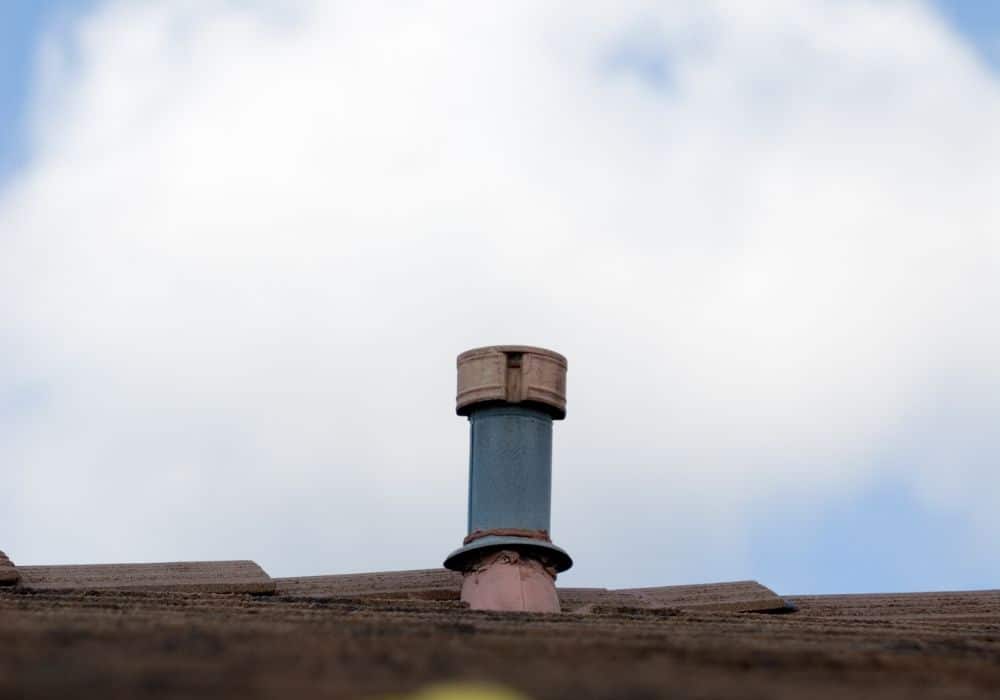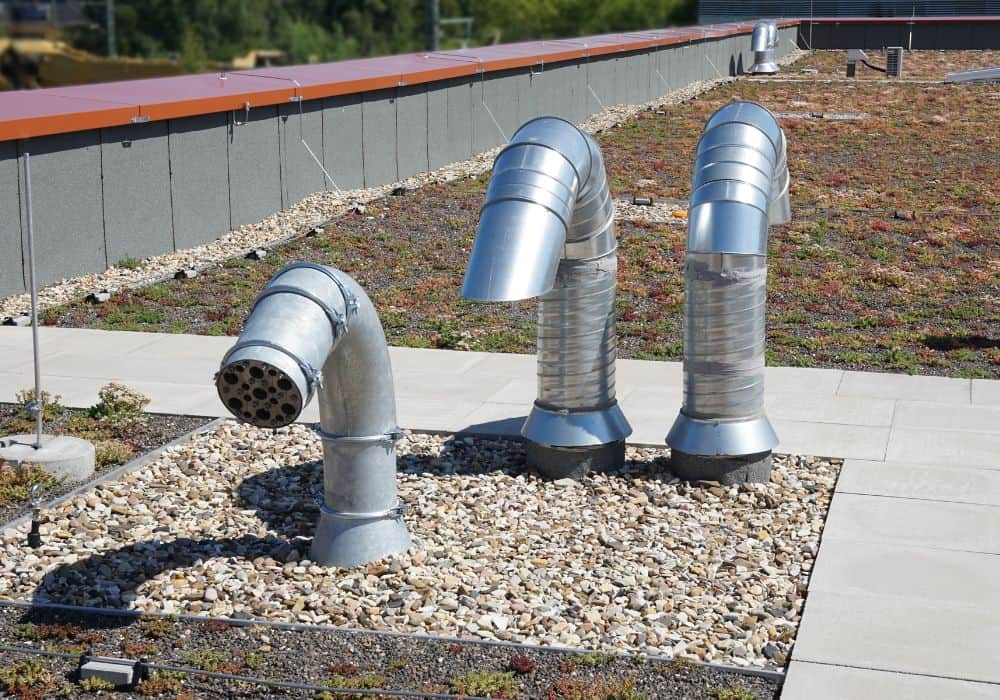Vent pipes are one of our homes’ most important but often underestimated pipes. They connect several plumbing systems together, taking everything from removing foul gas from our waste pipes to balancing atmospheric pressure and keeping drains working round the clock.
With so much going through the vent pipe, it’s only natural to expect it to become dirty, clogged, and worn down at some stage. But as inevitable as this is – there are ways to protect, clean, and improve your vent pipe’s condition.
This article will explore everything you need to know about cleaning your vent pipe. We will highlight why this needs to be done and offer expert advice on how often to clean, what technique to use, and more. The result? A clean, effective vent pipe that will surely last the test of time.
Equipment Needed
- Ladder and safety harness
- Screwdriver
- Garden hose
- Auger or hydro jetter
- Safe equipment, including rubber-soled shoes, gloves, and eye gear
If you’re climbing on top of your roof, ensure you follow basic health protocols. Choose a clear, calm day, and secure both you and your ladder appropriately, especially if your roof is relatively high from the ground.
Wear rubber-soled shoes for extra grit and grip on your roof surface, and always wear protective eye gear to shield you from splashback and potentially hazardous fumes.
Step-by-step on cleaning a vent pipe
1. Finding out the condition of your pipe
First, you need to get information on the interior condition of your vent pipe so that you can apply the most appropriate and effective cleaning method. Remove any vent hood on the top of the tube with a screwdriver.
This can be done in various ways, but using a drain snake is the most common. This is a long, narrow tube with a camera on the end that detect blockages, potential corrosion, and pipe breakages. A plumber’s snake drain with a flashlight on its end will be highly effective at detecting blockages further down your system.
For wider pipes, many plumbers prefer using an auger, though both function much the same.
2. Cleaning the blockages
If the snake drain has a hook on its end, that may be enough to shift dirt and debris or help remove troublesome blockages from clumped leaves, tennis balls, or tissue.
If the dirt is particularly stubborn, you may need to try applying water. Gently feed the garden hose down your vent pipe, turn it on, and the additional force of water can clean the interiors. Do not let the water run for too long; if the vent is clogged, the water will gather inside and apply additional pressure to the pipe’s structure.
3. Sewer jetter for added manpower
If your vent pipe is blocked and the hose is ineffective, you may try using a sewer jetter, otherwise known as a hydro jetter. These tools use incredibly high water pressure fired from a specialized nozzle that helps clear all obstructions found in vent pipes. You may need to repeat this process several times to fully expel debris and ensures a complete cleaning has been performed.

4. Re-examine your vent pipe
Once you’ve repeated the cleaning process and water is clearing out of the system, you can reposition the snake drain down the vent to see if there is any improvement.
You can ask someone inside your home to flush toilets one by one, turn on taps and faucets, and check that water runs smoothly and clearly through your system. If water is slow and discolored, the pipes in your plumbing system require further cleaning, not just the vent pipe.
Also, suppose there were unpleasant sewer gases emitting from your vent pipe, and they return quickly. In that case, this suggests a blockage further down your vent pipe than your plumber’s snake allows you to detect.
5. Should you use cleaning products to clean?
Often, when we clean vent pipes, it’s not solely for a glistening shine and clean exterior. Looks are not important – cleaning a vent pipe should focus on removing debris inside, not outside.
So should you use cleaning products for added power?
This ultimately depends on the type of cleaning you want to accomplish and the material of your pipe. In most, if not all, cases, water from a hose or jetter should be more than enough to rid clogs.
Using a chemical cleaning product will not necessarily remove debris inside the pipe. Additionally, several materials like PEX, PVC, and CPVC may be vulnerable to chemical agents in sanitary products.
Chlorine, for example, can cause oxidation in plastics, weakening their internal structure. Read the manufacturer’s instructions for clear guidelines, so your cleaning isn’t counter-productive.
FAQ:
When should you clean your vent pipe?
Because of its hidden placement in our homes, we rarely have a chance to check its structure and condition. For that reason, people often only clean it when a problem arises.
So what should you look out for? You should clean your vent pipe if you discover any of the following issues:
- Slow draining: A clog prevents air from traveling outside your plumbing system, creating a vacuum seal. This dramatically slows down sinks, tubs, and more draining speed.
- Gurgling: When you flush your toilet, there may be a loud “gurgling” sound. The air in the water has nowhere to escape because of a clog.
- Unpleasant odors: A toxic stench will build up within your house. The source will come from sinks or bathtubs.
Should you clean pipes during cold weather?
The winter months can cause problems for many of our pipes, but most importantly, the vent pipe. After all, the location of this tube often exposes it to colder temperatures.
If you need to clean your vent pipe in the cold and want to avoid climbing outside on the roof, consider these tips:
- Hot water: Letting the hot water run in your sinks and drains can send a surge of hot water vapor through your plumbing. This can help melt ice build-ups and flush your system.
- Heat at critical points: Warming the pipe may be enough to keep it frost-free. You can use your hair dryer or apply heat tape on areas particularly vulnerable to frost build-up, such as bends. Just be careful the pipe material can withstand heat application.
- Install proper installation: Insulating any pipe can help it repel the harmful effects of cold weather. Wrap your line in a suitable insulator, especially in areas where no internal heat is nearby.
Be careful sending too much water through your vent pipe to clean it. If that water settles inside and there’s an icy night forecast, this will only add to your problems.
When should you call a professional?
Although a toilet gurgling or a slow-draining sink may seem juvenile, a dirty vent pipe is something you must address as soon as possible. That is because of the potential for toxic gases to reenter and become trapped in your system.
Clogged sewage, for example, can produce methane gas which, when inhaled, can cause several problems, including nausea, vomiting, and headaches.
Call a professional plumber immediately if foul odors persist in your plumbing system.

Expert tips:
- Regular maintenance of your vent pipe will improve its function and longevity.
- Avoid harsh chemicals, especially with materials like PEX, PVC, and CPVC.
- Just cleaned your vent pipe and problems return? Then your pipes may suffer from corrosion, which cleaning will not help. Consulting with a professional plumber may get you answers to the core problem.
- No matter how often you clean vent pipes, if tree roots are growing nearby, this can cause irrevocable damage that cleaning will not fix.
- If animals are the sole cause of dirt in your vent pipes, such as bird nests or rodents, consider installing a vent pipe hood on top to secure it.
- Although cleaning vents may seem trivial, always ensure your safety – mainly if the pipe is on the top of your roof.
Conclusion
Because of how vital the vent pipe is to the overall plumbing system, it must remain in tip-top shape. Otherwise, as discussed, you’ll be met with bad smells, slow drains, and non-stop gurgling across your home.
Cleaning your vent pipe is a straightforward process, so long as you expel any debris that causes blockages. Blockages are the main culprits to dirt, grime, and molds developing throughout your pipe.
A combination of a garden hose, a plumbing snake, or an auger can shift through harmful material. But if the blockage is persistent, like tissue, you may need a hydro jetter for additional force.
Of course, if you still have questions on the best way to clean your vent pipes, leave a comment below. As always, remember:
- Ensure your safety when on your roof during the cleaning.
- Where possible, avoid harsh chemicals which may damage the structure of your vent.
- Regularly cleaning the vent pipe will prevent a build-up of debris, mold, moss, and other potential blockages.
